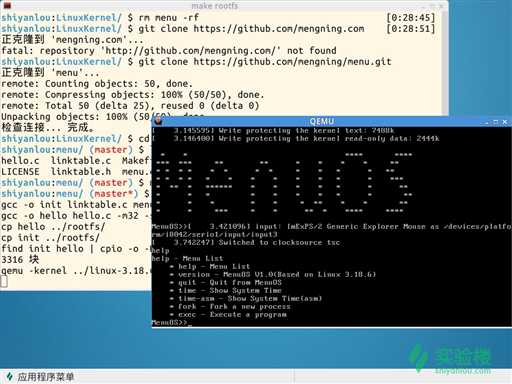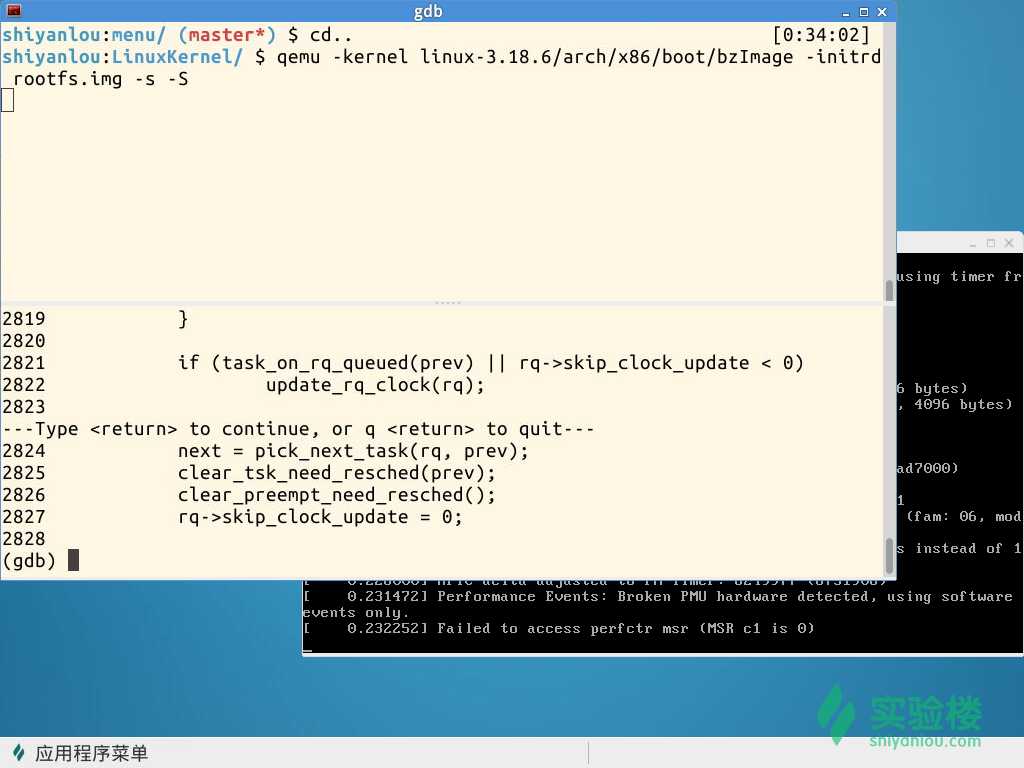标签:
一、理论知识
Linux系统的一般执行过程
最一般的情况:正在运行的用户态进程X切换到运行用户态进程Y的过程
1. 正在运行的用户态进程X
2. 发生中断——save cs:eip/esp/eflags(current) to kernel stack, then load cs:eip(entry of a specific ISR) and ss:esp(point to kernel stack).
3. SAVE_ALL //保存现场,这里是已经进入内核中断处里过程
4. 中断处理过程中或中断返回前调用了schedule(),其中的switch_to做了关键的进程上下文切换
5. 标号1之后开始运行用户态进程Y(这里Y曾经通过以上步骤被切换出去过因此可以从标号1继续执行)
6. restore_all //恢复现场
7. iret - pop cs:eip/ss:esp/eflags from kernel stack
8. 继续运行用户态进程Y
几种特殊情况
进程的调度时机与进程的切换
操作系统原理中介绍了大量进程调度算法,这些算法从实现的角度看仅仅是从运行队列中选择一个新进程,选择的过程中运用了不同的策略而已。
对于理解操作系统的工作机制,反而是进程的调度时机与进程的切换机制更为关键。
进程调度的时机
进程的切换
31#define switch_to(prev, next, last) \
32do { \
33 /* \
34 * Context-switching clobbers all registers, so we clobber \
35 * them explicitly, via unused output variables. \
36 * (EAX and EBP is not listed because EBP is saved/restored \
37 * explicitly for wchan access and EAX is the return value of \
38 * __switch_to()) \
39 */ \
40 unsigned long ebx, ecx, edx, esi, edi; \
41 \
42 asm volatile("pushfl\n\t" /* save flags */ \
43 "pushl %%ebp\n\t" /* save EBP */ \
44 "movl %%esp,%[prev_sp]\n\t" /* save ESP */ \
45 "movl %[next_sp],%%esp\n\t" /* restore ESP */ \
46 "movl $1f,%[prev_ip]\n\t" /* save EIP */ \
47 "pushl %[next_ip]\n\t" /* restore EIP */ \
48 __switch_canary \
49 "jmp __switch_to\n" /* regparm call */ \
50 "1:\t" /*下一个进程开始执行的地方!*/ \
51 "popl %%ebp\n\t" /* restore EBP */ \
52 "popfl\n" /* restore flags */ \
53 \
54 /* output parameters */ \
55 : [prev_sp] "=m" (prev->thread.sp), \
56 [prev_ip] "=m" (prev->thread.ip), \
57 "=a" (last), \
58 \
59 /* clobbered output registers: */ \
60 "=b" (ebx), "=c" (ecx), "=d" (edx), \
61 "=S" (esi), "=D" (edi) \
62 \
63 __switch_canary_oparam \
64 \
65 /* input parameters: */ \
66 : [next_sp] "m" (next->thread.sp), \
67 [next_ip] "m" (next->thread.ip), \
68 \
69 /* regparm parameters for __switch_to(): */ \
70 [prev] "a" (prev), \
71 [next] "d" (next) \
72 \
73 __switch_canary_iparam \
74 \
75 : /* reloaded segment registers */ \
76 "memory"); \
77} while (0)
二、实验
实验内容
1.理解Linux系统中进程调度的时机,可以在内核代码中搜索schedule()函数,看都是哪里调用了schedule(),判断我们课程内容中的总结是否准确;
2.使用gdb跟踪分析一个schedule()函数 ,验证您对Linux系统进程调度与进程切换过程的理解;推荐在实验楼Linux虚拟机环境下完成实验。
3.特别关注并仔细分析switch_to中的汇编代码,理解进程上下文的切换机制,以及与中断上下文切换的关系;
实验步骤
1. 打开实验楼虚拟机 https://www.shiyanlou.com/courses/running/890
2. 在shell中依次运行以下命令,获取本次实验的代码,并编译运行
cd LinuxKernel
rm menu -rf
git clone https://github.com/mengning/menu.git
cd menu
mv test_exec.c test.c
make rootfs
效果如下:

3. 关闭QEMU窗口,在shell窗口中,cd LinuxKernel回退到LinuxKernel目录,使用下面的命令启动内核并在CPU运行代码前停下以便调试:
qemu -kernel linux-3.18.6/arch/x86/boot/bzImage -initrd rootfs.img -s -S
接下来,我们就可以水平分割一个新的shell窗口出来,依次使用下面的命令启动gdb调试
gdb
(gdb) file linux-3.18.6/vmlinux
(gdb) target remote:1234
并在系统调用
关闭QEMU窗口,在shell窗口中,cd LinuxKernel回退到LinuxKernel目录,使用下面的命令启动内核并在CPU运行代码前停下以便调试:
qemu -kernel linux-3.18.6/arch/x86/boot/bzImage -initrd rootfs.img -s -S
接下来,我们就可以水平分割一个新的shell窗口出来,依次使用下面的命令启动gdb调试
gdb
(gdb) file linux-3.18.6/vmlinux
(gdb) target remote:1234
并在内核函数schedule的入口处设置断点,接下来输入c继续执行,则系统即可停在该函数处,接下来我们就可以使用命令n或者s逐步跟踪,可以详细浏览pick_next_task,switch_to等函数的执行过程




标签:
原文地址:http://www.cnblogs.com/qinzhoaqi/p/5400266.html